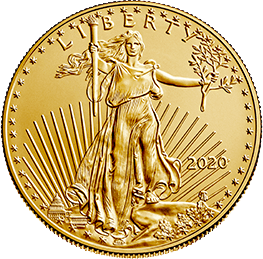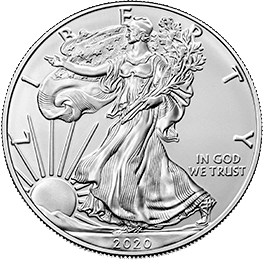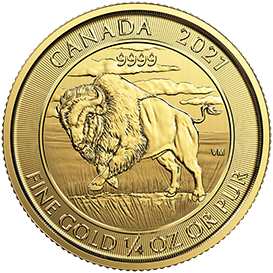
Buy Canadian Maple Leaf Coins
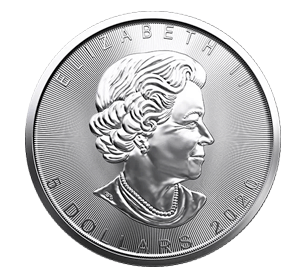
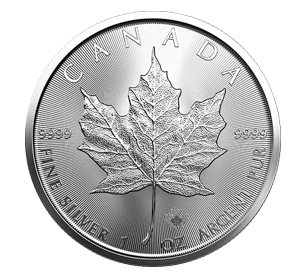



- The Silver Canadian Maple Leaf coin is a gorgeous example of coin mintage that is prized highly for its stunning .9999 metal purity. The reverse of the coin features the maple leaf that gives the coin its name, similar to the Gold Canadian Maple Leaf coin. The leaf is surrounded by a remarkable radial line pattern that is extremely hard to duplicate. The Canadian Silver Maple Leaf is collected avidly by many and has the investment potential of pure fine silver bullion.
Coin Details
Coin Design
- Obverse: Queen Elizabeth II shown in right-side profile
- Reverse: A detailed maple leaf engraving shown before a beautiful radial line pattern, as well as weight and purity marks
Free Insured Shipping
Price Match Guarantee
Buy-Back Commitment
Canadian Maple Leaf Coins
The Canadian Maple Leaf coin is one of the most popular coins in the world, issued annually by the Royal Canadian Mint under the Canadian government. It was first introduced in 1979 and is named for the iconic Canadian symbol, the maple leaf, which adorns one side of the coin.
Gold Maple Leaf: The Canadian Gold Maple Leaf coin was the first in the series. It was initially made from .999, 24-karat gold, but in 1982, the mint increased the purity to .9999, making it one of the purest gold coins available. In addition, a few special edition Canadian Gold Maple Leaf coins have been released with a purity of .99999 gold content.
Silver Maple Leaf: The Canadian Silver Maple Leaf coin was introduced in 1988. Like the Gold Maple Leaf, the Silver version boasts a high purity level of .9999.
Platinum and Palladium Maple Leaf: The Canadian Platinum Maple Leaf coin and the Canadian Palladium Maple Leaf coin variants were introduced, in 1988 and 2005, respectively. Both coins also have a purity of .9995.
One side of the coin features the profile of her majesty Queen Elizabeth II, while the other side showcases a maple leaf, one of Canada’s national symbols. The face value, year of issue, and the word “Canada” are also inscribed on the coins. The coins are available in various sizes, with the standard fine gold and silver coins having a face value of 50 and 5 Canadian dollars. The face value of the currency does not reflect its intrinsic metal value, which typically far exceeds its face value. The Royal Canadian Mint has also issued several special editions and variants of the Maple Leaf coins, including coins with holographic enhancements, colored maple leaves, and privy marks to commemorative special events or anniversaries. These coins are highly regarded for their quality and design, and they are widely traded internationally, making them a popular choice for investors and collectors.
Maple Leaf Symbolism
As mentioned, the Canadian maple leaf is one of Canada’s most prominent national symbols, representing the country’s identity and pride. It appears on the national flag and is widely used in official symbols and emblems. On the Canadian Maple Leaf coins, the maple leaf symbolizes several values:
Canadian identity and heritage: As a symbol, the maple leaf is deeply intertwined with the country’s history. Its use on the coin serves as a reminder of Canadian heritage, echoing themes of resilience, respect for nature, and the country’s ties to its beautiful and expansive wilderness.
Nature and environment: The maple leaf represents the Canadian appreciation for nature and the environment. Maple trees are common throughout much of Canada, and the changing color of their leaves in autumn is often associated with the country’s natural beauty.
Purity and quality: The Royal Mint’s use of the maple leaf also symbolizes their coins’ high standard and purity. For example, the Gold Maple Leaf coin was one of the first gold bullion coins minted at .9999 fineness. In this sense, the maple lead also represents the excellence and high-quality standards of the Royal Canadian Mint.
Strength and endurance: Like the maple tree, known for its hardiness and ability to withstand harsh conditions, the maple leaf symbol also stands for strength and endurance. This resonates well with the inherent value and stability that precious metals like gold, silver, platinum, and palladium offer.
Overall, the image of the maple leaf on these coins encapsulates Canada’s national identity and values and is a testament to the nation’s natural beauty. It’s a symbol that resonates with Canadians and is recognized worldwide.
Mintage
The Gold Maple Leaf coin, introduced in 1979, quickly became one of the world’s most popular pure gold coins. Over one million units were sold within the first three years of production. By the mid-2000s, that number had grown to over 20 million.
The Silver Maple Leaf coin, introduced in 1988, also saw a robust demand. By 2000, the Royal Canadian Mint reported that more than 10 million had been sold. In recent years, the mintage for individual years often exceeds 25 million coins, reflecting the high global demand for silver.
The Platinum and Palladium Maple Leaf coins have typically seen lower mintages reflecting the more niche demand for these metals.
Design of the Canadian Maple Leaf Coins
The Canadian Maple Leaf coins, whether gold, silver, platinum, or palladium, share a similar base design.
Obverse
The obverse (front) of the coin depicts a profile of her majesty Queen Elizabeth II. Over the years, as the coins have been issued, the portrait of the Queen has been updated to reflect her aging. You will find three main versions: the young Queen portrait (coins minted from 1979-1989), the mature Queen portrait (coins minted from 1990-2003), and the elderly Queen portrait (coins minted from 2004-present). The obverse also included inscriptions for the face value of the currency and the year of minting.
Reverse
The reverse (back) of the coin features the iconic Canadian maple leaf, hence the name of the coin series. The maple leaf is shown in fine detail, highlighting the Royal Canadian Mint’s commitment to high-quality minting. The reverse also includes inscriptions for the country of issue, “CANADA,” the coin’s purity, and the metal content. Over the years, the Royal Canadian Mint has also released special edition or variant designs of the Maple Leaf coins. These variants can include privy marks (small symbols or inscriptions) to commemorate special events or anniversaries, color enhancements, or different finishes. For example, some unique edition coins have been issued with a holographic maple leaf or a leaf colored in autumnal hues. Despite these special editions, the basic design — Queen Elizabeth II on the obverse and the maple leaf on the reverse — has remained consistent for the Gold, Silver, Platinum, and Palladium Maple Leaf coins.
Canadian Maple Leaf Coin Purity
Canadian Gold Maple Leaf coins are known for their high purity levels. They are made from .9999, 24-karat pure gold, meaning they contain virtually no other metal alloy. Some unique edition coins have even been made at .99999 purity. In terms of size, the standard Gold Maple Leaf coin contains one troy ounce (about 31.1 grams) of gold. However, the Canadian Mint also produced fractional sizes, including ½, ¼, 1/10, 1/20, and 1/25 troy-ounce coins. The standard one troy-ounce Gold Maple Leaf coin is 30 mm long, and the standard one troy-ounce Gold Maple Leaf coin is 2.87 mm thick.
What Is the Difference Between a Gold Coin and a Gold Bar?
Gold coins and gold bars are valuable forms of bullion that investors and collectors often buy for their intrinsic gold value. However, there are a few key differences between them:
Design and artistry: Gold coins, such as the Canadian Gold Maple Leaf, often feature intricate designs and are produced with a high level of craftsmanship. They can be more aesthetically pleasing than gold bars and often have historical and national symbols, which make them more appealing to collectors.
Denominations and sizes: Gold coins usually come in standardized denominations and sizes, making them more convenient for trade or sale. On the other hand, gold bars come in various weights and sizes, from 1-gram bars to large 400-troy-ounce bars.
Legal tender status: Gold coins issued by national mints are often legal tender in the country of issue, meaning they have a face value and could theoretically be used to purchase goods and services (though their metal value usually far exceeds their face value). Gold bars do not have a face value and are not legal tender.
Price and premium: Both gold coins and bars carry a premium over the spot price of gold, which is the cost to manufacture, distribute, and sell the product. However, the premium is often higher for gold coins due to their design and the legal tender status.
Storage and transport: Gold bars, especially larger ones, can be more challenging to store and transport than gold coins. They may also be harder to sell quickly since finding a buyer for a large gold bar may be more complex than a smaller gold coin.
Purity: Both gold bars and coins can be very high in purity, but it’s often easier to find .9999 pure gold coins than gold bars. Some gold bars may be .999 or less pure.
Ultimately, choosing between gold coins and bars often comes down to personal preferences, investment goals, and logistical considerations.
About Canadian Maple Leaf Coins
Canadian Maple Leaf coins are a popular choice for both investors and collectors. They are recognized globally for their high purity and quality. Here’s an overview of the different types of Maple Leaf coins:
Canadian Gold Maple Leaf Coins
The Canadian Gold Maple Leaf coins were introduced in 1979 and are .9999 fine gold, making them one of the purest gold bullion coins available in the world. They come in several denominations, such as 1/20 oz, 1/10 oz, ¼ oz, ½ oz, and 1 oz. Gold is traditionally seen as a safe-haven asset, especially during economic uncertainty.
Canadian Silver Maple Leaf Coins
First minted by the government of Canada in 1988, Silver Maple Leafs are .9999 pure silver, making them some of the most pure silver coins available. Silver’s lower price point than gold makes these coins more accessible to a broader range of clients.
Canadian Platinum and Palladium Maple Leaf Coins
Introduced in 1988, discontinued in 2002, and reintroduced in 2009, these coins are made from .9995 pure platinum. As platinum is rarer than gold or silver, these coins can be an excellent way to diversify a precious metals portfolio. The Palladium Maple Leaf coins were first produced in 2005, and these coins are .9995 pure palladium. Palladium, a precious metal often used in the automotive industry, can provide a hedge against inflation and diversify an investment portfolio. Another popular way to invest in these numismatic coins would be to open a Gold IRA.
Purchasing Canadian Maple Leaf Coins
Canadian Maple Leaf coins, known for their high purity and quality, are a globally recognized safe haven asset. Available in gold, silver, platinum, and palladium, these coins offer an excellent way to diversify your portfolio. Whether you’re drawn to the .9999 pure Gold and Silver Maple Leafs or the .9995 pure platinum and palladium variants, each coin represents a piece of Canadian heritage through the iconic maple leaf symbol. Contact American Hartford Gold to make these esteemed coins a part of your financial strategy. Their team of experts can guide you through the purchasing process, ensuring you make the most informed decisions for your numismatic precious metals portfolio.
Related Products
Get Your Free 2024 Guide

Most Recent News


From Bidenomics to Kamalafare

Gold as a Safe Haven During Political Upheaval
About American Hartford Gold
American Hartford Gold (AHG) the leading Gold & Silver Specialists that helps individuals and families diversify and protect their wealth with precious metals. Through our website, publications and expert Product Specialists, American Hartford Gold offers a wealth of precious metals market perspective that empowers both new and experienced investors.
Get Your FREE Gold & Silver Information Guide

CONTACT US
Los Angeles
11755 Wilshire Blvd. 11th Floor
Los Angeles, CA 90025
Phone: 800-462-0071
Email: info@hgoldgroup.com
Woodland Hills
21550 Oxnard Street Suite 705
Woodland Hills, CA 91367
HELPFUL LINKS
The statements made on this website are opinions and past performance is no indication of future performance or returns. Precious metals, like all investments, carry risk. Gold, silver and platinum coins and bars may appreciate, depreciate or stay the same depending on a variety of factors. American Hartford Gold. cannot guarantee, and makes no representation that any metals purchased will appreciate at all or appreciate sufficiently to make customers a profit. The decision to purchase or sell precious metals, and which precious metals to purchase or sell are the customer’s decision alone, and purchases and sales should be made subject to the customer’s own research, prudence and judgement. American Hartford Gold. does not provide investment, legal, retirement planning, or tax advice. Individuals should consult with their investment, legal or tax professionals for such services.
